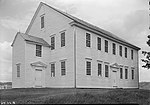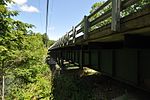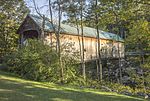Rockingham, Vermont

Rockingham is a town along the Connecticut River in Windham County, Vermont, United States. As of the 2020 census, the population was 4,832. Rockingham includes the incorporated villages of Bellows Falls and Saxtons River, as well as a large rural area west of Interstate 91. Rockingham has no formal town center; instead, town offices and the Rockingham Public Library are located in the village of Bellows Falls. The approximate center is the Rockingham Meeting House, passed by Route 103, a popular east–west route across the state. The Meeting House was built in Rockingham Village, once the main settlement in the town, but with the increased use of water power for manufacturing, population shifted to other villages located on the two rivers in the town. Most of what was left of Rockingham Village (over a dozen buildings, also called the Old Town) burned in a fire on April 14, 1908; the fire came close to the Meeting House but it was saved. The houses, hotel, and store that burned were not rebuilt.
Excerpt from the Wikipedia article Rockingham, Vermont (License: CC BY-SA 3.0, Authors, Images).Rockingham, Vermont
Rockingham
Geographical coordinates (GPS) Address Nearby Places Show on map
Geographical coordinates (GPS)
| Latitude | Longitude |
|---|---|
| N 43.165833333333 ° | E -72.481666666667 ° |
Address
Brockways Mills
05101 Rockingham
Vermont, United States
Open on Google Maps











